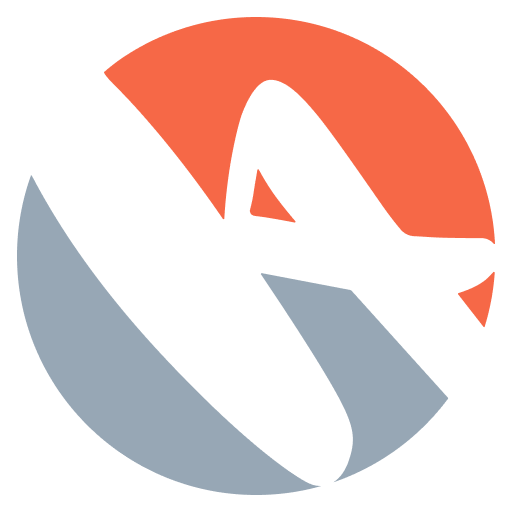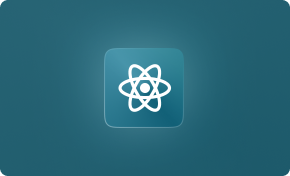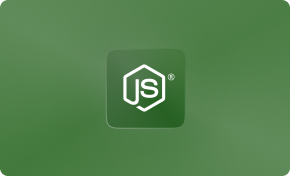Artificial intelligence (AI) brings about great benefits, but the cost of integrating AI is something that organizations must consider when determining how to integrate it. Two popular options appear: greenfield AI development (creating new AI systems from scratch) and the incorporation of AI into the existing infrastructure.
Every strategy has various total cost of ownership (TCO) implications. This article is a handy, cross-industry breakdown of the immediate and long-term costs of either route. We will break down the key cost drivers, such as infrastructure and labor, time-to-value, and maintenance, and give an easy ROI calculator template to calculate returns. When both technical teams and business leaders comprehend the complete financial landscape of AI integration cost, they will be able to make informed decisions.
In case you are at the very start of your journey, the article AI Integration for Business: Practical Steps to Implement and Scale will be a great guide to pair with, as it gives you a basic understanding of how to implement scalable AI systems.
Greenfield AI Development vs. Integrating into Existing Systems
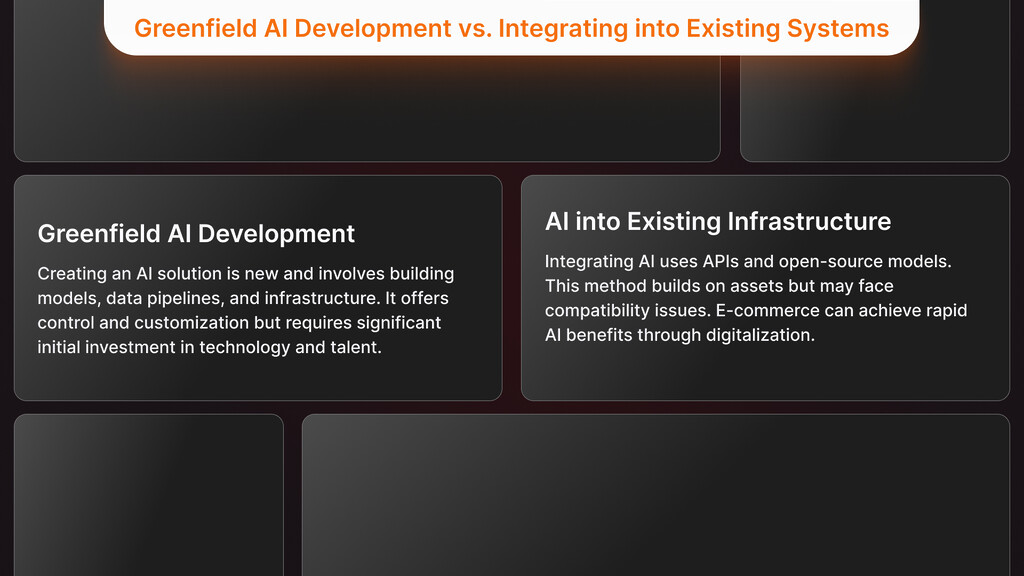
Prior to examining aspects of costs, it is necessary to explain the following two methods:
Greenfield AI Development
The creation of an AI solution is completely new, with a green field essentially. This implies the creation of new models, data pipelines, and potentially the implementation of new infrastructure. It has the benefit of the highest level of control and customization; however, it demands a lot of initial investment in technology and talent.
AI into Existing Infrastructure
Integration of AI into your existing infrastructure (usually referred to as a brownfield approach). That may include the involvement of ready-made AI solutions (third-party APIs, platforms, or open-sourced models) and bridging them over your legacy systems. It is usually cheaper to implement initially and can be deployed more quickly because you are building on what you have and are not creating something new; however, you are likely to be restricted in some way by a vendor or compatibility problem.
According to the AI Integration for Business: Practical Steps to Implement and Scale, this kind of environment is characterized by integration frequently being a multi-stage rollout and process digitalization, with industries such as e-commerce and finance being the ones where the quickest AI benefits can be achieved with the help of the current processes and workflows.
The two strategies are both based on delivering AI-driven value, but their cost structures are very different. We compare these approaches in the subsequent sections on the major cost drivers in order to shed light on their total cost of ownership.
Key Cost Drivers in AI Integration Costs vs. Greenfield Development

The effective adoption of AI has many cost elements. How does greenfield development and incorporation of AI into existing infrastructure compare as far as infrastructure, labor, time-to-value, and maintenance costs are concerned?
Infrastructure Costs
With green field projects, you begin with a stack that is modern and usually on cloud native platforms such as AWS, Azure, or GCP. This will lower the cost of maintenance and make AI models scalable in demand.
Cutting-Edge Custom Software Development for Your Success
Create Software That Meets Your Specific Requirements
Explore Custom SoftwareGreenfield Approach
Designing AI aspects is sometimes associated with heavy infrastructural spending. Companies may also be required to purchase high-performance computing (GPUs, storage, networking) or rent cloud resources to train and deploy AI models. Such capital investments may be high, as an AI system to support a custom enterprise usually begins with an up-front investment of at least $100,000 to $500,000+. Infrastructure costs on state-of-the-art work (e.g., training very large models) may balloon into the millions of dollars in terms of compute. The advantage is that the full infrastructure is under your control and can be customized to your requirements, and this may translate to cost savings at scale (no third-party consumption charges).
Integration Approach
AI can be used to implement in existing systems, thereby lowering the initial infrastructure spending. In many cases, teams need not develop their own platforms to utilize AI, as they can rent the capabilities on cloud services or APIs. Commercial AI platforms may offer a small subscription fee (in some cases, $200-$400 per month, in case of simple use).
And it does not require standing up new servers and data centers to be used during initial deployments; the heavy lifting (model hosting, data storage) is taken care of by the provider. This brings the short-term cost of infrastructure much cheaper than that of greenfield construction. Nevertheless, the cost of long-term operation may be cumulative. Pay-as-you-go billing implies that when you increase the use of AI, so do the costs.
To give one example, a report showed that processing images in large quantities (1 million calls a day) using a cloud AI API could be more than $300,000 a month, at which point it could be cheaper to develop an internal solution (with a dedicated team and GPU cluster) in the long run. Therefore, although the integration of AI uses the infrastructure that is already in place and does not require incurring massive upfront investments, organizations will need to consider the subscription or use costs and the potential need to invest in the upgrade of legacy systems in order to support the AI workload.
Conversely, the AI in the existing systems usually implies modernizing legacy platforms. To take an example, the article Automation & AI: How Genetic Testing Labs Beat Staffing Shortagesdemonstrates how labs are updating infrastructure through AI-powered automation in order to address resource scarcity, which requires bringing backend infrastructure up to date.
Short-Term vs. Long-Term
In the short term, it is cost-effective to rely on existing infrastructure or cloud AI services and accelerate adoption. However, in the longer term, green field investments can be written as assets, but integration services that are continuing to be offered or upgrades needed to systems are included in TCO. It has been reported that 65% of software costs are incurred post-deployment, i.e., are not factored into the initial decision. However, long-term factors such as scaling and power costs (e.g., power and cooling of AI hardware) are paramount when considering infrastructure options.
Labor and Talent Costs
Greenfield Approach
The AI development is a talent-intensive process. One needs to recruit data scientists, machine learning engineers, and domain experts, and pay their salaries, which can be high, say, between $100,000 and $300,000 a year, to experienced AI professionals. Also, the companies might have to spend money to educate the current employees about the new.
The competitive AI talent market has the potential to increase the costs (and high turnover rates are something to be afraid of, as they will result in frequent hiring expenses). In lieu of these expenses, you will enjoy complete control and ownership of the intellectual property of your AI solution, and your staff will accumulate expertise, which may become a long-term asset.
Integration Approach
A ready-made AI solution can reduce the possibility of having a large in-house AI team, at least at the beginning. Rather than a complete department of data scientists, you may only require a handful of engineers or consultants to set up APIs, perform data integration, and keep the interface between the AI service and your systems up and running.
Redefine Your IT Strategy with Our Consultancy
Customized Solutions for Optimal Performance
Discover IT ConsultingThis outsourcing or partnering practice can provide solutions 5-7 months quicker on average than the process of hiring and developing completely internally, saving a significant amount of time and wage costs in the short term. Nevertheless, installation does not come free of charge: you still might have to arrange collaboration with vendor experts or educate your IT personnel to handle the built-in system.
Another line item on the cost list is consulting and integration services (one source mentions that companies tend to spend most of the budget of AI projects on data integration and custom connectors, 60-80%). In the long term, the use of external vendors may imply a lower level of capacity development internally. In case your strategic plan is to develop AI competency within your organization, a pure integration strategy may reduce such growth, and later you may end up paying more to bring talents to make deeper customizations.
The Short-Term vs. the Long-Term
Short term, the high cost of forming a complete AI team may be avoided by outsourcing AI services or using turn-key solutions, which is appealing to fast wins. The long-term costs are unknown to most organizations: they may lose their knowledge should any key individuals leave (knowledge silos), or risk vendor lock-in should no one in the organization know the artificial intelligence (vendor dependency).
Also, the expense of getting talent in the future may go higher in case you failed to develop it in the past when AI was central to business. It is important to balance short-term savings of labor costs and strategic workforce development.
Time-to-Value and Deployment Speed
Greenfield Approach
The development of an AI solution based on scratch is typically a more prolonged process. The development cycle may take months or more than a year for complex systems. This reduced speed of time-to-markettranslates to delayed value creation, and that cost of delay has an opportunity cost.
Indeed, it is estimated that companies may lose up to 20-30% of the potential income every year because of the inefficiencies in their business processes when they cannot improve them because of delays with the AI implementation. The immediate disadvantage is evident: greenfield projects are considered to have a longer runway to get some ROI. A custom AI can, however, be tweaked once it is deployed in order to maximize its value, possibly exceeding a generic one in the long run.
Your Path to Innovation Starts with Digital Transformation
Customized Digital Strategies for Competitive Advantage
Explore Digital TransformationIntegration Approach
Time-to-value can be reduced drastically with the integration of AI with existing infrastructure. Organizations can get up and running in days or weeks rather than months by delivering pre-built models or by using cloud AI services. This pace delivers returns ahead of schedule – an example is using an AI API straight out of the box that can begin paying off within a short time, making it worth the initial outlay.
The faster deployment is not only quicker ROI, but it also decreases the chance that a project will be cancelled because it runs over budget or priorities change (another common issue when a schedule gets too long). The tradeoff may be that an off-the-shelf solution will be less customized; sometimes, companies will be willing to experience a little less customization in exchange for a much quicker payoff. In the long term, the fast kickstart provided by integration can be iteratively enhanced or even a phase-two custom build once the idea has been proven.
Short-term vs. Long-term
Time-to-value is a key factor in the short term in favor of integration: the quicker it can be deployed, the faster the benefits (cost savings, new revenue, efficiency gains) will start accruing, and therefore the better the short-term ROI. Long-term consideration should be given as to whether the speed advantage in the first place is still worth it. A bespoke solution that appears subsequently may eventually provide more cumulative value in case it is much more effective or cost-efficient.
Therefore, hybrid approaches are sometimes adopted by organizations: adopt fast-win AI solutions initially, and then substitute or augment them over time, as they become more mature, with custom-built elements. The trick is to measure the money saved in time. To use the words of one analysis, by speeding up an AI deployment by a matter of months, one can salvage hundreds of thousands of dollars in opportunity costs that would otherwise be lost in the slack effort.
Maintenance and Long-Term Support
Greenfield Approach
Having a bespoke AI system implies having its maintenance as well. Bugs have to be fixed, models have to be retrained with the data drifting, and the software libraries should be updated. Such continuous operations typically consume 10-20% of an annual AI budget in terms of maintenance and support. As an example, one company may pay about 10,000+ a year to maintain a custom solution, in addition to computing costs that are increasing (computing costs are rising in the cloud, and for AI, computing costs were projected to rise by ~89% between 2023 and 2025).
Then there is technical debt to be considered, a system that has been built out of scratch over time can build up what is known as technical debt, as old parts or workarounds can become expensive to fix. Studies indicate that the cost of future repairs can increase significantly (potentially multiple times the initial cost) if required upgrades or refactoring are not performed in a timely manner. Overall, a greenfield AI will need ongoing investment in the engineering and potentially redesigns over the long term. The advantage is that you can do the enhancement or upgrading of the system at your own pace, and you are not under the obligation of upgrades to vendors or changes in licenses.
Integration Approach
In the case of third-party AI integration, there is some outsourcing of maintenance. The vendor is usually involved in upgrading AI models, enhancing the platform, and making the service reliable. This saves your internal teams; you will not have to continually patch the AI algorithm yourself. But integration is associated with its maintenance issues.
You will have to keep the integration layer up to date, e.g., in case the vendor has revised their API, you might have to revise your application. Making sure how data is being transferred between your legacy system and the AI service is a continuous process (particularly as they both develop). Also, you can encounter upgrade/ subscription fees in the long run. Vendors may alter prices or rules of licensing, and being on a legacy version may not be an option, and you may be pushed to upgrade every now and then (requiring payments to professional services).
The risk of vendor lock-in: over 80% of organizations that invest heavily in cloud services experience some form of lock-in, and switching to a different provider in the future can prove to be expensive. Typically, the reintegration and retraining on a new platform cost twice as much as the initial investment. Regarding the long-term support, the fact that you use an external AI may make everyday maintenance of the model less complicated, but you will give up on the ability to control the roadmap and the quality of support.
Short-Term vs. Long-Term
In the short run, integrated solutions are a godsend because they reduce the effort required to maintain them after launching is minimal, almost nothing beyond tracking the usage and making small-scale changes to the integration. Long-term costs will appear in other ways: when you need to renew subscriptions, when additional costs might be incurred, when you may have to re-integrate with a vendor in the event you exceed them, or when the vendor ends the service.
An in-house developed AI could be more expensive in terms of maintenance, but the expenses are more easily controlled by you. It is a good idea to budget TCO on a multi-year basis: e.g., to consider that additional support and upgrades may cost you 5-20K dollars per month on enterprise AI, and any compliance expenses (which can run into the tens of thousands in regulated industries, e.g. another 10k-100k per year to keep the AI systems audit-compatible). When you consider maintenance in the TCO, you do not get any shocks when the AI is implemented.
Other industries, such as healthcare or MedTech, that we present inRevolutionary Applications of Large Language Models (LLMs) in MedTechhave even stricter requirements due to AI compliance, which can significantly affect TCO when using AI in legacy systems.
Estimating ROI and Total Cost of Ownership
In comparing the alternatives in AI implementation, one should not merely compare the initial cost but also figure out the return on investment (ROI) of the solution throughout its life. ROI assists in relating the costs to the anticipated advantages (e.g., revenue increase, cost reduction, efficiency).
The formula for ROI is straightforward:
ROI = (Total Benefits – Total Investment) / Total Investment × 100%.
To calculate these numbers for AI, it is necessary to consider not only the costs we have briefly discussed but also the schedule of benefits. An accelerated integration could begin to deliver value during Month 1, whereas a custom-built one could deliver more value a year later. These are some of the guidelines for ROI estimation:
Leading Research & Development for Your Success
Driving Innovation in Every Product Aspect Through R&D-Driven Software
Learn About R&D Services- Make a List of Advantages: Determine the financial effect of the AI solution (e.g., automation results in savings, new income through more efficient products, decrease in error or downtime).
- Add Up All Costs: Add up the initial development or setup costs, and any ongoing costs that may be subscriptions, infrastructure, and people. Keep in mind that 65%+ expenses may be visible after deployment is done, so add multi-year maintenance and support.
- Time Frame: Choose an analysis period (usually 3 or 5 years in the case of the AI projects). It will enable comparison of equal-footing ROI between options.
- Think about Risk and Flexibility: In one case, there might be a greater likelihood of the overrun in costs or failure of the project, and you could then decrease the projected ROI or budget in contingency expenses.
ROI Calculator Template
The table below is a basic ROI calculator. You may enter your own assumptions in each category to compare the greenfield alternative and the integration alternative. In the interest of illustration, we have put in dummy values (fill in with your real or estimated values).
| Approach | Initial Investment | Annual Operating Costs (e.g. maintenance, licenses) | Annual Benefits (savings or revenue) | Estimated 3-Year ROI |
|---|---|---|---|---|
| Greenfield AI Development | $[Initial_G] | $[Annual_G] | $[Benefit_G] | =((3×Benefit_G) - (Initial_G + 3×Annual_G)) / (Initial_G + 3×Annual_G) × 100% |
| AI Integration (Existing Infra) | $[Initial_I] | $[Annual_I] | $[Benefit_I] | =((3×Benefit_I) - (Initial_I + 3×Annual_I)) / (Initial_I + 3×Annual_I) × 100% |
The present template is based on a 3-year forecast. In computing the costs and benefits of each of these approaches, you should add the total cost (initial + 3 annual costs) and the total benefit (3 annual benefits). At this point, the formula of ROI (as a percentage) can be used. As an example, one of the AI solutions may cost less up front but more in annual costs, so its ROI may be high in the first year but will stagnate in the third year.
On the other hand, a greenfield project may yield negative ROI in the first year (because it will be heavily invested), but it may give a high ROI in the third year, provided the annual benefits are compounded and the costs are not increasing significantly. Fit this framework to your situation – you can take it up to 5 years, or add other line items (such as one-off training expense or decommissioning expense) as required.
(Note: ROI is not the only measurement. Internal Rate of Return (IRR) or payback period will also be more complete, particularly on long-term projects, as ROI does not reflect the time value of money or intermediate cash flows.)
Choosing the Right Approach: Organizational Factors
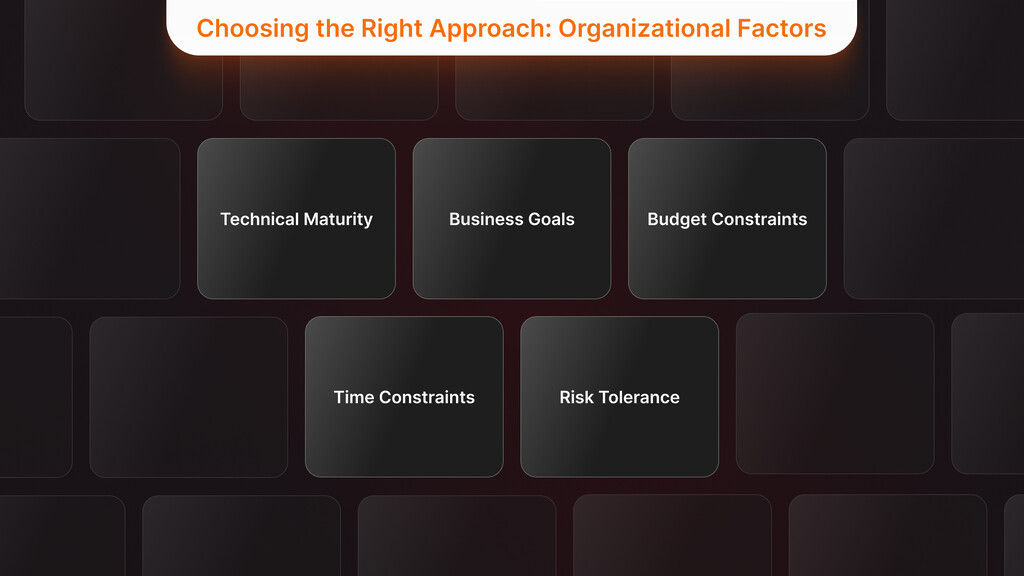
The choice of developing a new AI solution or adding AI to what you already have is not an entirely algebraic question of costs and benefits: it is also about the maturity, objectives, and limitations of your organization.
Technical Maturity
Assessing the current capacity of your organization, you can be in a good position to choose a greenfield development and address the costs of further development in case you have a good data infrastructure and AI talent on board. Conversely, when you are new to the world of AI, it may be smart to integrate an existing third-party solution to make your way up the learning curve at less risk.
Business Goals
Be clear as to what you are pursuing. In case AI is going to become a key differentiator or product in your business, custom solution can be worth the investment (and you will not be in the situation to be confined by the capabilities of the vendors as your business evolves).
In case, however, the objective is a solution of a frequently occurring issue (such as incorporating AI analytics into back-office processes) or achieving immediate efficiency benefits, an integration strategy will be able to yield faster results with fewer disruptions. Other companies even consider integration itself as a pilot project: demonstrate the ROI with a quick win and invest in a custom solution as soon as the concept is proven.
Budget Constraints
Of course, the choice will depend on the available budget. Greenfield AI projects need a large initial budget outlay (capital expenditure), but integration can frequently be carried out using operating expenditure at any one time. In case of constrained capital, the integration of AI via the as-a-service model (monthly or annual payment) could be more viable. However, keep in mind that you should compare TCO on the long term – what may seem cheaper in the first year is more expensive in the fifth year when subscription prices or overall savings are high.
Time Constraints
In case of urgency (competitive pressure or internal deadlines), integration is typically quicker to implement, as it has been observed. As an example, integrating an AI API may allow you to launch a new capability in the next quarter, but implementing a custom AI can delay the launch by a year. Integration will be favored in fast-follow markets or situations in which it is important to be first. Nevertheless, in the case of a long-term strategic project, a well-developed solution might be worth the wait.
Mobile App Development for a Competitive Edge
Developing Mobile Apps that Engage Your Customers with Your Brand
Explore Mobile App DevelopmentRisk Tolerance
Greenfield projects are associated with increased risk of development failure, i.e., there is a risk that the project will be over-budget and/or not achieve its goals (in fact, 67% of software projects fail because of inappropriate build-vs-buy decisions, according to one research). Independent AI is usually riskier to integrate, but there is less technological risk (how will a third-party product behave and integrate?). Low-risk tolerant organizations might be led to employ a tried-and-true integration, whereas risk-taking organizations might be led to build in-house in order to gain a larger reward.
The correct action is not always a simple either-or. Most organizations begin with off-the-shelf AI plug-ins to their existing infrastructure to gain initial wins and build slowly over time as they develop custom AI components as their capabilities mature, in effect, a hybrid strategy. This has the potential to offset short-term ROI and long-term flexibility.
Navigating AI Integration Costs for Optimal Results
To sum up, the total cost of ownership of AI integration is an essential concept in ensuring a wise decision is made regarding AI projects. Greenfield AI development requires more up-front costs and energy, but can be more fully controlled and potentially more profitable in the long term after a system is operating continuously.
Bringing AI to existing infrastructure is a faster and lower-entry barrier route to AI adoption, but with lower up-front costs, which can be more expensive in the long run due to subscription fees, vendor lock-in, and scaling. Each of these strategies has large fractions of its costs post-deployment (it is important to note that most of the costs of an AI solution are usually incurred in the operation of the solution and not in its build process).
Finally, your decision must be consistent with the strategy and resources available in your organization. An established firm having unique requirements and sufficient resources may invest in a customized AI solution to fuel competitive advantage. An integration that gives rapid improvements and a shorter ROI may be a prudent choice for a smaller or resource-constrained organization.
Take a bigger picture into account: consider the ratio of infrastructure costs and labor costs, compare the time to value and window of opportunity, and estimate the maintenance requirements in the long term. This way, you will be able to determine the best total cost of ownership solution for your scenario and make your AI investment sustainable. The idea is to use AI in such a manner that it aligns with your business objectives without any unexpected costs in the long term – the option that will transform AI investments from a bleeding-edge cost to a high-ROI investment.
At HyperSense Software, we assist companies in all industries to plan and deploy AI solutions that work within the architecture of their business, old or new. When you are ready to start your AI roadmap journey, contact our AI integration professionals to begin your transformation today.
Key Takeaways
- Greenfield development is flexible and performs in the long run, but it requires more up-front investment and thus requires more time to deploy.
- The AI integration into the current systems brings faster wins at lower initial costs and can cost more over a long period because of legacy limitations.
- The most important cost drivers are the maturity of infrastructure, data readiness, the complexity of compliance, and architecture type.
- ROI and TCO depend on deployment strategy, timeline, and use case.
What is the difference between greenfield AI development and AI integration into existing infrastructure?
Greenfield AI development involves building your AI systems from scratch, leveraging current architectures, cloud-native platforms (such as AWS or Azure), and custom data pipelines. It is the most flexible, scalable, and the owner of the AI solution. Instead, AI integration links AI models, APIs, or platforms with your existing software infrastructure. It is cheaper and quicker at the start, but can have customization and scalability problems in the long term. The selection of the two options will be based on your digital maturity, business targets, and budget.
Which is more expensive: greenfield or integration?
Greenfield ventures are also more costly in the initial investment, as these projects can cost 100,000-500,000 or more, since they include infrastructure establishment, talent acquisition, and development time. Nevertheless, they can provide lower long-term operating costs and higher returns. Integration is less expensive to start with, and in some cases, monthly subscriptions to AI services start at $200-400, though costs increase with scale. Such recurrent expenses may outweigh the initial savings in a couple of years, making greenfield more economical in the long run.
How fast can we see ROI with each approach?
Intellection AI is more rapid to value. Ready-made models and APIs can begin delivering results in weeks or months and can be used to enhance operations or automate practically instantly. Greenfield projects, on the contrary, require 6-18 months to yield returns. Nonetheless, when deployed, bespoke AI systems are generally more effective, scalable, and customized -providing higher ROI over the long run.
How does infrastructure impact AI project costs?
A significant cost driver is infrastructure. Greenfield AI needs to provision cloud compute (e.g., GPU clusters), data lakes, orchestration pipelines, and secure storage —sometimes in the hundreds of thousands to support large models. AI integration can use your current platform or a third-party platform. Although this lowers the costs of setup, recurring cloud usage, and data transfer, poor control may raise TCO in the long run, particularly for high-volume use.
Why is it important to include maintenance in TCO calculations?
Most enterprises do not take maintenance seriously. For greenfield projects, model retraining, software updates, and infrastructure scaling can consume 10-20% of the AI budget per year. When integrating, it partially outsources maintenance to these vendors; however, you still have to handle integration, API versioning, and service maintenance. Over time, vendor-imposed price increases can become extremely expensive, especially for maintenance costs. These should be included in your Total Cost of Ownership (TCO), as it will give you a realistic budget and sustainability.
What are the major labor cost differences between greenfield and integration?
The development of greenfield AI also entails the employment of highly paid specialists in data science, machine learning, and DevOps roles, with salaries ranging from $100,000 to $300,000 per year per position. The advantage: complete IP ownership and the development of internal capabilities. Implementing AI can be handled by a small team within the company or by external consultants, which lowers initial costs and delivery time. However, excessive reliance on external vendors can impair the ability to scale or tailor AI solutions in the future.
What are the long-term risks of integrating third-party AI solutions?
The most significant long-term risk is vendor lock-in. The more you depend, the more you are exposed to pricing variations, service restrictions, and the lack of control over the roadmap. There are high reintegration, retraining, and migration costs associated with switching providers, including, in some cases, twice the original provision cost. When outsourcing critical AI functions, the risks of data privacy breaches, noncompliance, and service degradation also increase.
Can greenfield projects be more sustainable over time?
Yes. Although Greenfield needs a higher start-up, it offers long-term sustainability in terms of control, possession of the system, and flexibility. Companies that create their own AI can retrain, scale, and optimize systems at their own pace —without paying increasingly expensive third-party fees. This increases the resiliency of greenfield to firms with AI as a core strategy or product to customers.
What factors should influence the decision between greenfield and integration?
Key considerations include:
- Digital maturity (data infrastructure, DevOps maturity)
- Time-to-market needs
- Budget plan (CapEx vs OpEx)
- Talent availability
- Strategic importance of AI
Greenfield is most appropriate when AI is a differentiator and in-house capacity is strong. Incremental innovation, faster rollouts, or low-risk experimentation are best suited to integration.
Is there a recommended hybrid approach?
Yes. A hybrid approach is often used by many companies: initially, they implement AI integration (e.g., third-party APIs for chatbots or image recognition) to win quickly, and over time, as more strategic use cases arise, they switch to more custom-built greenfield systems. This balances the short-term ROI and long-term flexibility. It works best for medium-sized companies looking to experiment with AI and build internal capacity to own it over time.
How can ROI be estimated for AI investments?
A simple formula:
ROI = (Total Benefits – Total Investment) / Total Investment × 100%
To estimate accurately:
- Add all upfront costs (development, licensing)
- Include ongoing costs (subscriptions, maintenance, cloud fees)
- Project revenue uplift or savings (labor, operations, conversions)
Evaluate over 3–5 years for both integration and greenfield approaches. Greenfield might deliver slower but compounding returns, while integration often yields faster, smaller gains.
Is it true that most AI costs come after deployment?
Yes. Research shows 65%+ of AI project costs occur after the system goes live. These include:
- Model retraining and tuning
- Compliance audits
- Scaling infrastructure
- Vendor renewals or API changes
The cost of ignoring the post-deployments may lead to budgetary excess. Multi-year TCO projections are part of smart planning to avoid surprises and guarantee ROI.

